Happy Valentines Day! We may not be sending you a card, flowers or chocolates, but we love all our listeners.& This week's show is all about the science of love and bonding, we'll be exploring the molecules that mediate monogamy, finding out how women subconsciously advertise their fertility, and looking at the evolutionary basis for falling in love.& Plus, in Kitchen Science, Ben and Dave make invisible ink for sending secret love letters...
In this episode
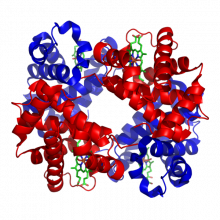
Molecule muscles more oxygen off haemoglobin to boost performance and beat heart failure
Scientists have developed a new molecule that can provoke haemoglobin, the red oxygen-bearing pigment in blood, to release its oxygen cargo more readily, boosting muscle power.
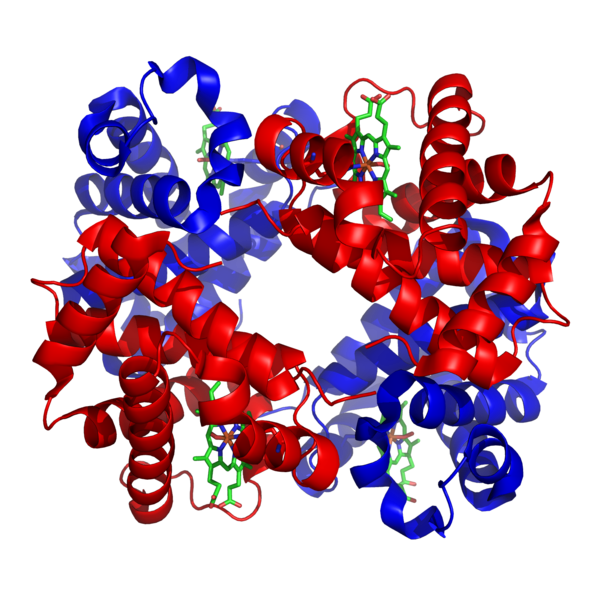 Writing in this week's PNAS, Boston University Medical Centre researcher Andreia Biolo and her colleagues describe a new molecule ITPP - myo-inositol trispyrophosphate - which can mimic the way the body adapts to high altitude by penetrating red blood cells and locking onto the haemoglobin molecules inside. This causes the haemoglobin molecules to alter their shape slightly, loosening their grip on the oxygen molecules they pick up from the lungs. As a result the cells give up the oxygen far more readily to the tissues. Tests in healthy mice showed that ITPP-treated animals had 50% greater exercise endurance compared with their untreated littermates.
Writing in this week's PNAS, Boston University Medical Centre researcher Andreia Biolo and her colleagues describe a new molecule ITPP - myo-inositol trispyrophosphate - which can mimic the way the body adapts to high altitude by penetrating red blood cells and locking onto the haemoglobin molecules inside. This causes the haemoglobin molecules to alter their shape slightly, loosening their grip on the oxygen molecules they pick up from the lungs. As a result the cells give up the oxygen far more readily to the tissues. Tests in healthy mice showed that ITPP-treated animals had 50% greater exercise endurance compared with their untreated littermates.
But even more encouragingly, when the agent was administered to animals with an inherited form of heart failure (a dilated cardiomyopathy), their capacity for exercise increased by 70% because the demands on the heart were lower because the animals' muscles were able to obtain the oxygen they needed at lower levels of blood flow. This, say the researchers, may be a highly effective way to improve the lives of patients disabled by heart failure, particularly since ITPP seems to be orally-active in the experimental mice. But they will, first, need to prove that the agent is safe first before human trials can begin.
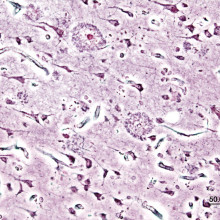
03:51 - New way to block Alzheimer's
New way to block Alzheimer's
Scientists have uncovered two new approaches to blocking the progression of Alzheimer's disease. The two separate studies, one from a Belgian group of researchers from the Catholic University of Leuven and published in the journal Science and the other from an NIH team in Bethesda, US and published in PNAS, focus on the mechanism by which a protein called beta amyloid, which builds up in the brains of Alzheimer's patients, is formed and how it harms cells.
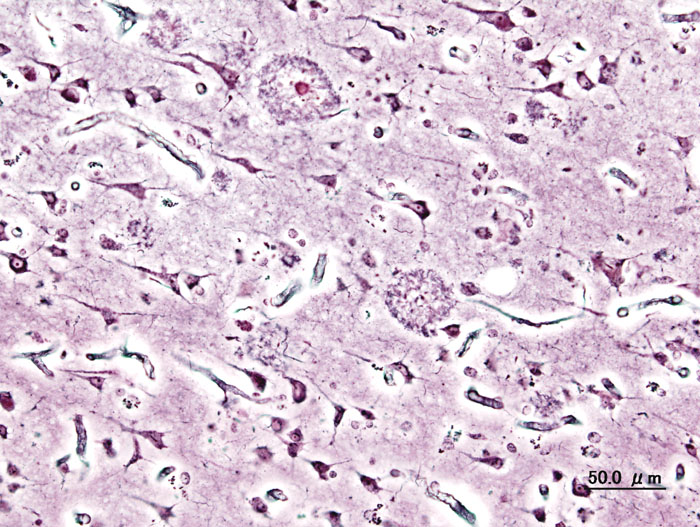 |
| Histopathogic image of senile plaques seen in the cerebral cortex in a patient with Alzheimer disease of pre-senile onset. Silver impregnation. © KGH |
In the Science paper Amantha Thathiah and colleagues used a genetic technique to look for chemical messengers that, when added to cells, increased beta amyloid production. Using this approach they were able to home in on a signalling molecule called G protein-coupled receptor 3 (GPR-3), which turns on an enzyme called gamma-secretase, which in turn produces beta amyloid. As the team expected, turning off the molecule reduced beta-amyloid production whilst boosting its levels increased beta-amyloid. Encouragingly, GPR-3 is only expressed in the brain, which means it might be possible to engineer a drug designed to target selectively this receptor, thus minimising the side effects, which have plagued earlier anti-Alzheimer's drug strategies.
Meanwhile, the PNAS paper by Juan Carlos Diaz and his colleagues tests the theory that the beta-amyloid that builds up in the brain damages nerve cells by forming new pores in the nerve cell membranes. These pores allow calcium to flow into the cell, causing it to become over-excited and die. To combat the problem the team have engineered two new drug molecules, which have been designed specifically to block up these hypothetical pores.
Working with cultured cells the team added beta amyloid alone or beta amyloid plus one of the two blocking drugs and used sensitive measuring techniques to monitor the flow of calcium into the cells. Cells incubated with just beta amyloid showed high levels of cell death preceeded by calcium flowing in. But cells treated with the two new compounds showed equivalent survival rates to untreated control cells.
"If the neurotoxic mechanism for amyloid beta is the formation of toxic calcium channels, then compounds that block the channels can logically be considered candidate Alzheimer's drugs," says the researchers.
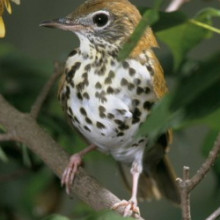
Sing a song of distance
Scientists have discovered that song birds fly much faster during their migrations than previously thought.
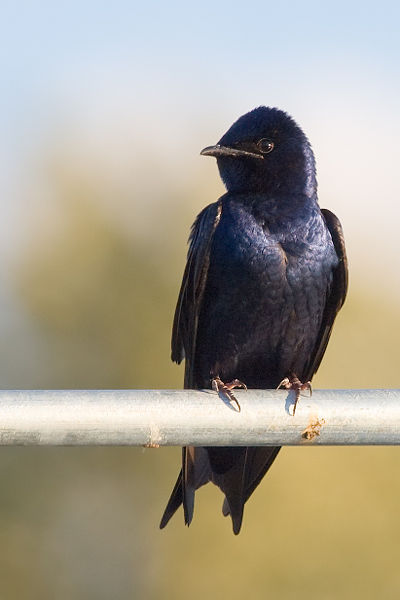 Writing in this week's Science, York University, Canada researcher Bridget Stutchbury and her colleagues tracked the progress of two species of migrating birds, wood thrushes and purple martins. The team trapped birds in their native Pennsylvania and equipped them with tiny geolocator backpacks. These devices continually log light levels, allowing the position of a bird wearing one to be accurately pinpointed by referring to the sunrise and sunset times, which of course vary geographically. Once tagged the birds were released and embarked on their winter migrations to South America.
Writing in this week's Science, York University, Canada researcher Bridget Stutchbury and her colleagues tracked the progress of two species of migrating birds, wood thrushes and purple martins. The team trapped birds in their native Pennsylvania and equipped them with tiny geolocator backpacks. These devices continually log light levels, allowing the position of a bird wearing one to be accurately pinpointed by referring to the sunrise and sunset times, which of course vary geographically. Once tagged the birds were released and embarked on their winter migrations to South America.
The following year, when the birds returned to their US mating sites, the team re-captured a number of them and downloaded the data from the geo-locators, enabling the routes the birds had taken, and over what time periods, to be retraced.
"Never before has anyone been able to track songbirds for their entire migratory trip," says study author Bridget Stutchbury. Previous estimates had put the birds' speeds at at about 93 miles (150 km) per day, but the new results show that they are covering more than three times that distance. They were also up to six times faster returning in the spring for mating that during the outward leg when there's a competitive advantage to being the first back because early arrivals have access to the best nest sites and the most food.
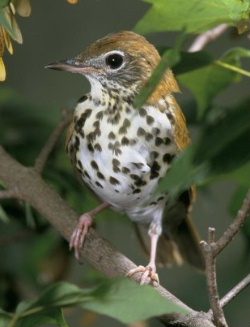 Even so, the researchers were surprised by the results. "We were flabbergasted by the birds' spring return times. To have a bird leave Brazil on April 12 and be home by the end of the month was just astounding. We always assumed they left sometime in March," Stutchbury said. The researchers also found that prolonged stopovers were common during fall migration. The purple martins, which are members of the swallow family, had a stopover of three to four weeks in the Yucatan before continuing to Brazil. Four wood thrushes spent one to two weeks in the southeastern United States in late October, before crossing the Gulf of Mexico, and two other individuals stopped on the Yucatan Peninsula for two to four weeks before continuing migration.
Even so, the researchers were surprised by the results. "We were flabbergasted by the birds' spring return times. To have a bird leave Brazil on April 12 and be home by the end of the month was just astounding. We always assumed they left sometime in March," Stutchbury said. The researchers also found that prolonged stopovers were common during fall migration. The purple martins, which are members of the swallow family, had a stopover of three to four weeks in the Yucatan before continuing to Brazil. Four wood thrushes spent one to two weeks in the southeastern United States in late October, before crossing the Gulf of Mexico, and two other individuals stopped on the Yucatan Peninsula for two to four weeks before continuing migration.
This work is extremely important from a conservation perspective. "Songbird populations have been declining around the world for 30 or 40 years, so there is a lot of concern about them," points out Stutchbury. "Tracking birds to their wintering areas is also essential for predicting the impact of tropical habitat loss and climate change. Until now, our hands have been tied in many ways, because we didn't know where the birds were going. They would just disappear and then come back in the spring. It's wonderful to now have a window into their journey."
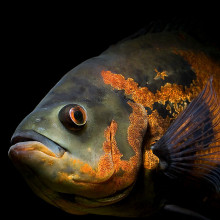
08:32 - The Genetic Root of All Teeth
The Genetic Root of All Teeth
with Dr Todd Streelman,
Chris - Also in the news this week, researchers at Georgia institute of Technology in Atlanta have discovered the genetic 'root' of all teeth!
By looking at a type of fish called Cichlids, which have teeth both in the mouth and the throat, they noticed that the development of both sets of teeth is controlled by the same set of genes. The same genes could also control the pattern of growth of feathers and hair - so could shed more light on some of the big evolutionary changes of the past.
Dr Todd Streelman, one of the authors on this week's Public Library of Science paper, joins us now...
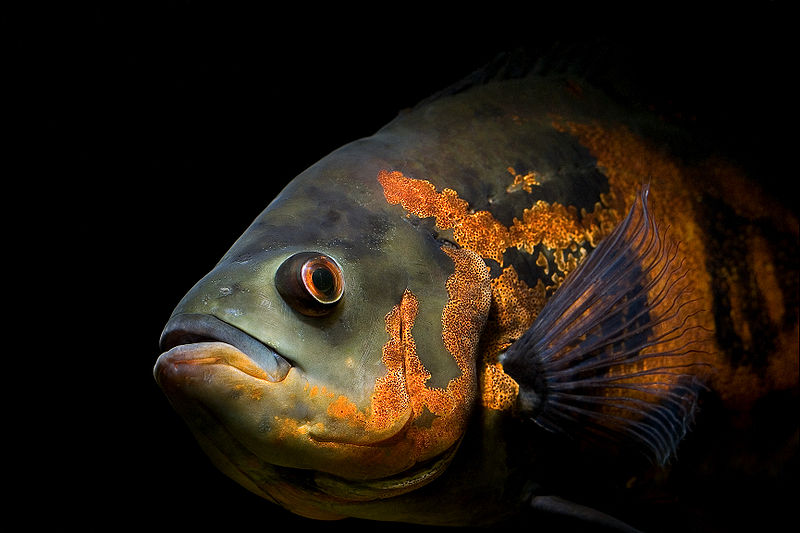 Todd - We study a very unique group of fishes from Lake Malawi in East Africa. What's so fascinating about them is that they express a tremendous diversity of all sorts of things like colour patterns and brain function and also their teeth. We were able to make use of this natural diversity to begin to ask the question about how they actually make teeth in two different places on the body. Once we found the answer to that we put this information together with lots of information in the literature to try to understand how teeth were made a long time ago and also to try to understand the things in common between all teeth that we presently know about.
Todd - We study a very unique group of fishes from Lake Malawi in East Africa. What's so fascinating about them is that they express a tremendous diversity of all sorts of things like colour patterns and brain function and also their teeth. We were able to make use of this natural diversity to begin to ask the question about how they actually make teeth in two different places on the body. Once we found the answer to that we put this information together with lots of information in the literature to try to understand how teeth were made a long time ago and also to try to understand the things in common between all teeth that we presently know about.
Chris - What was the genetic clue that tells you where the teeth have come from in the first place?
Todd - This is one of the interesting things that many people don't know, the co-evolutionary history of teeth and jaws. Teeth first of all: about half a billion years ago they evolved in organisms that did not have jaws. Interestingly enough they evolved first in the pharynx, deep in the throat. Then they also evolved on the oral jaw, the jaw on the front of our face, when that jaw first appeared in vertebrate history. As you imagined in the fishes we studied they had teeth both on their oral jaw but they also have teeth back in this ancestral location for teeth. We used a technique called in situ hybridisation which is just a way to visualise where and when genes are active. We studied a number of molecules that we had some inkling might be involved in dentition. We identified two things. We identified this ancient set of genes and that ancient set of genes is the set of genes that's on in the pharynx when teeth are made. Secondly we identified a core set of genes. That core set represents the gene at work that's active in all teeth. From the fishes we study to shark, to mice and in your teeth as well.
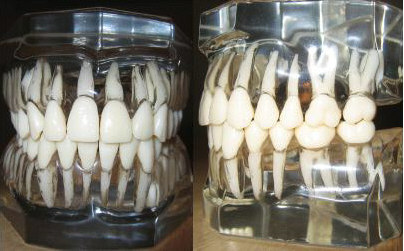 Chris - When you study an early human embryo you can see the same vestiges as the development of a fish occurring in us, for instance. We get gills at certain stages of development too, don't we? We get these bronchial arches which, some of them, turn into things like our ear drums and out tonsils. In fish they would have been gills but superimposed on that is this pattern of genes that gives us teeth.
Chris - When you study an early human embryo you can see the same vestiges as the development of a fish occurring in us, for instance. We get gills at certain stages of development too, don't we? We get these bronchial arches which, some of them, turn into things like our ear drums and out tonsils. In fish they would have been gills but superimposed on that is this pattern of genes that gives us teeth.
Todd - That's right. There's a very old rule in evolutionary biology called ontogeny recapitulates phylogenies. That just means that, in a very coarse way, if you look at a contemporary organism and look at its development you can learn something about evolutionary vestiges by studying early phases of its development. That's one of the things we take advantage of. We also were able to identify some differences between this ancestral network active in these throat teeth and the core network that's active in the oral jaw of most organisms. We think those are probably some of the genes that tell us about some of the things that have changed as dentitions have evolved over half a billion years. For instance, in the fishes we study they replace every single tooth about every 50-100 days. This is one of these things we think - and other people have suggested also- links teeth to other structures like feathers and hairs that also have this capacity for regeneration. Your teeth are replaced a single time but other mammals never replace their teeth. These are aspects of dentition that have been lost as teeth have evolved. Some of those interesting regenerative capacities are still present in both the pharyngeal and oral teeth that we studied.

How much water is in the world?
Chris - Best estimate I know, Bill, is we think there are 1.37 billion cubic km of water on Earth!

Secret messages - what makes an Invisible Ink?

Why do we wake up when we need to urinate?
Chris - It's the same reflex if you need to roll over in bed when you're uncomfortable. If you stayed in one position in bed all the time all night you would get a pressure sore because the pressure of tissue against the bed would stop blood flow through that area. As a result you would end up with a de-vascularised bit of skin and it would necrose. Patients who are left in one position in hospital for too long get exactly the same problem. The body has a series of reflexes programmed into it even when you are asleep. You can react and respond to various stimuli with an appropriate thing. If you're getting uncomfortable in bed you can roll over. If, on the other hand, your bladder's getting full then your brain says wake up, you need to go to the loo. It's an automatic reflex. Some people lose that reflex as they get older. Some people when they're very little actually wet the bed because it hasn't developed yet. That's why little kiddies have to respond to those signals the right way. That's all about potty training and bladder training.

19:32 - Molecules that Mediate Monogamy
Molecules that Mediate Monogamy
with Dr Larry Young, Yerkes National Primate Research Centre
Chris - What's going on biologically to make us monogamous? Professor Larry Young is from the Yerkes National Primate Research Centre at Emory University in the States. He's looking at molecules that mediate this monogamy.
 Larry - My research is really trying to understand the social brain, what makes us want to engage in social interactions and form social relationships. The way that I've been going about doing that is by studying these interesting little rodents called prairie voles. Prairie voles look somewhat like a hamster. They're from the Midwestern United States and what makes them so interesting is that, like people they are monogamous. They form bonds like partners which may sound not so strange. In fact, in the animal world only about 5% of species form any kind of relationship with their partner. We do experiments to try to understand what is the chemistry or the genetics that is underlying their ability to form these lifelong bonds with the partners.
Larry - My research is really trying to understand the social brain, what makes us want to engage in social interactions and form social relationships. The way that I've been going about doing that is by studying these interesting little rodents called prairie voles. Prairie voles look somewhat like a hamster. They're from the Midwestern United States and what makes them so interesting is that, like people they are monogamous. They form bonds like partners which may sound not so strange. In fact, in the animal world only about 5% of species form any kind of relationship with their partner. We do experiments to try to understand what is the chemistry or the genetics that is underlying their ability to form these lifelong bonds with the partners.
Chris - What do you think the advantage to something like the prairie voles you're studying is to forming a monogamous bond? The fact that nature does is so rarely, as you point out, suggests that it could be disadvantageous under certain circumstances.
Larry - I think under most circumstances it probably is, at least for most males, disadvantageous for them to form the bonds. If you're a male in most cases you would think that your best strategy would be to mate with as many females as you possibly can. There may be certain types of environments like where the prairie vole goes where there are certain predators around. If you're a male and you mate with females but don't help them take care of the offspring then the female has to leave the babies in the nest every day while she forages maybe all her babies are getting eaten.
Chris - When you study the brains of the animals, presumably this is a behavioural thing, choosing to be monogamous. What do you find?
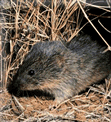 Larry - In the prairie moles there's a molecule called oxytocin. This is a protein hormone that most of us know about because of its role in initiating labour, childbirth and also lactation. This same molecule is known to be responsible for causing mothers to bond with their babies. It's also involved in the female bonding with the male. We know this because we can take a female prairie vole and place her in the cage with a male and don't let them mate. They're not mating partners but if we infuse a bit of oxytocin into her brain she will instantly bond with that male. We can also do a converse experiment where we block the oxytocin and let her mate with a male and she'll never bond with that male. In males it's a different molecule called vasopressin. It's also a protein hormone. It's really interesting that you can have a single molecule like this that plays such an important role in the ability to bond.
Larry - In the prairie moles there's a molecule called oxytocin. This is a protein hormone that most of us know about because of its role in initiating labour, childbirth and also lactation. This same molecule is known to be responsible for causing mothers to bond with their babies. It's also involved in the female bonding with the male. We know this because we can take a female prairie vole and place her in the cage with a male and don't let them mate. They're not mating partners but if we infuse a bit of oxytocin into her brain she will instantly bond with that male. We can also do a converse experiment where we block the oxytocin and let her mate with a male and she'll never bond with that male. In males it's a different molecule called vasopressin. It's also a protein hormone. It's really interesting that you can have a single molecule like this that plays such an important role in the ability to bond.
Chris - Some people have suggested that the bonding process is the same thing between two adult humans and as you get between a mother and a baby. It's just that the love idea, two people getting together, is exploiting the same neurochemistry as when a mother bonds with her baby.
Larry - That's a good point. In all mammal species you have this circuitry in the brain that allows the mother to bond with the baby and take care of the baby. That's an essential kind of behaviour. Oxytocin's released when she gives birth and when she is nursing her babies. Oxytocin is also released when animals mate. It seems that what happens on the occasion when evolution prefers the monogamy kind of behaviour that those circuitries get tweaked a little bit. Now the bond is not towards the baby but, in addition, towards the male partner.
Chris - So having sex does drive a stronger bond, establish trust between a male and a female? That could be part of the role of this hormone system - to make people who are going to have offspring bond together so they'll take care of that offspring.
Larry - We believe that to be true. We know oxytocin is involved in that and it's interesting that you used the word trust. There have been some studies in humans now to ask, does this hormone really affect human behaviour and human mating? The studies are pretty convincing that it does. There was one study that showed if you inhale oxytocin you trust other people more. You can actually infer their emotions better by just looking at their facial expression. It seems that oxytocin is tugging us in to a social world around us.
Chris - You mentioned that in females it's the oxytocin playing a big role and in males there's a different molecule, argentine vasopressin. Why is there that dichotomy? Do the two hormones have the same effect in the opposite effect, they're just used differently?
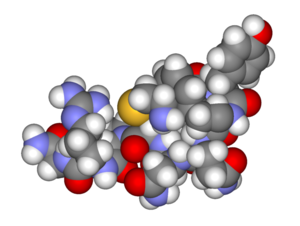 Larry - Argenine vasopressin is a sexually dimorphic molecule which means that males have much more of this than females. If you look across the animal kingdom you'll find that vasopressin tends to do the behaviours that are, sort of, the macho behaviours of that species. In some species it increases aggression. It increases territorial behaviours and whatever the males of that species typically do, that's what vasopressin controls. It seems in monogamy involved in this species it was tweaked a little bit so that the same hormone that controls macho behaviour now controls this bonding behaviour.
Larry - Argenine vasopressin is a sexually dimorphic molecule which means that males have much more of this than females. If you look across the animal kingdom you'll find that vasopressin tends to do the behaviours that are, sort of, the macho behaviours of that species. In some species it increases aggression. It increases territorial behaviours and whatever the males of that species typically do, that's what vasopressin controls. It seems in monogamy involved in this species it was tweaked a little bit so that the same hormone that controls macho behaviour now controls this bonding behaviour.
Chris - If we look at people that do seem to have a problem with a roving eye, they can't keep their hands off anyone of the opposite sex, do they have a problem with that hormone system?
Larry - We don't know that for sure. We're just at the very beginning of doing human studies. There has been an interesting study that came out that does suggest the vasopressin receptor, which is the protein that responds to vasopressin much like a key in a lock system, and there are variations in that gene. We found in voles that if you have a certain variation of that receptor you were much less likely to form an attachment with a female than if you had other variations. A Swedish group has done a similar study in humans and found that individuals who have two copies of one particular variant of the vasopressin receptor gene are twice as likely to report that they have crises in their relationship of the past year or twice as likely to never get married in the first place. They remain in a live-in relationship but no commit to marriage. It seems possible this system may have some impact on our own ability to form relationships and the kind of relationships that we form.
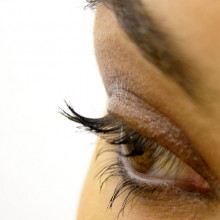
26:55 - Advertising Fertility
Advertising Fertility
with Dr Martie Haselton, UCLA
Helen - Dr Martie Haselton is Assistant Professor at UCLA and she works on the changes we see in behaviour when women are at their most fertile. We have Martie on the phone now. Hi Martie. As well as sending out valentines cards what other ways do we broadcast our fertility?
 Martie - We found in several studies there are cues in the fertility cycle. There are subtle ways that women might be revealing when they are in the fertile window of their cycle. Whether they are near ovulation, the time when a woman is likely to conceive. In one study we found that women wore more fashionable clothing during that time. In another study that was just published that women voices became more feminine on high fertility days.
Martie - We found in several studies there are cues in the fertility cycle. There are subtle ways that women might be revealing when they are in the fertile window of their cycle. Whether they are near ovulation, the time when a woman is likely to conceive. In one study we found that women wore more fashionable clothing during that time. In another study that was just published that women voices became more feminine on high fertility days.
Helen - How do you mean more feminine?
Martie - Specifically we recorded the women's voices at two points in the cycle: one during the fertile window during ovulation and several days beforehand and then another period shortly before that but before menstrual or premenstrual days. We did hormone tests to verify that women in their high fertility window were in fact close to ovulation. We took our vocal clips and submitted them to acoustical analysis to see what the differences were between them.
Helen - We have a couple of those recordings now. Shall we have a listen to those and see what they actually came out like? First we have one that came at the low fertility part of the cycle.
"Hi, I'm a student at UCLA" during a low fertility part of the menstrual cycle.
Helen - We should point out, actually, that we've changed the voices a little bit so you can't recognise who that is. It's a little bit robotic but that's just to keep their identity hidden. Shall we listen to the same person at a different, more fertile time of the cycle?
"Hi, I'm a student at UCLA" during a high fertility part of the menstrual cycle.
Martie - That's a great example. The thing we found that differentiated high fertility voices for most was vocal pitch. Women's voices are higher in pitch than men's. This is one of the things that differentiates the sound of a male and female voice. Hormones are associated with the onset of those sex differences. When girls go through puberty their voices begin to sound more feminine. Particularly they become higher in pitch relative to boys of the same age. We suspected that oestrogen might play a role in this and it might show differences across the cycle because oestrogen varies across the cycle along with other sex hormones, which is precisely what we found.
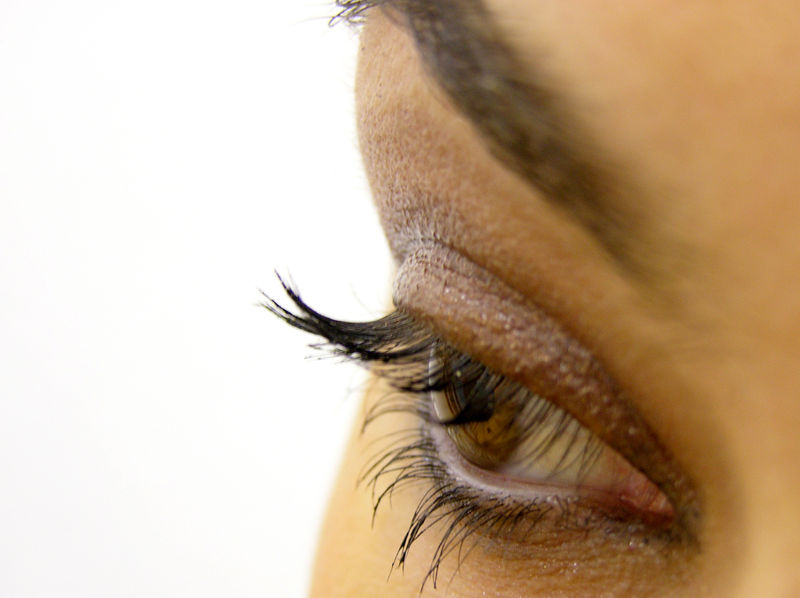 Helen - It seems it could be these hormones that are changing our voices. I presume, are we aware of this at all? I don't suppose we are...
Helen - It seems it could be these hormones that are changing our voices. I presume, are we aware of this at all? I don't suppose we are...
Martie - No, I don't think we're aware of any of these subtle clues of ovulation. In another study that we did we found that women reported feeling sexy and more attractive on high fertility days in their cycle. They didn't know, we weren't asking them, "it's a high fertility day of your cycle, how do you feel?" Instead we just asked them questions repeatedly, over a series of 35 days and we found that they reported a slight upswing on near ovulation and how attractive they felt. It's possible there are many cues that are linked with attractiveness including vocal femininity that change across the cycle.
Helen - A lot of women these days are on the pill which means that their hormones aren't moving up and down in the same way and we don't have those peaks in fertility because our bodies are being convinced that they are actually fertile all the time. Do we know if that's having any effect? Are women on the pill putting out different signals?
Martie - One of the clues in the voice study was that women on the pill - around menstruation there is thought to be a phenomenon of vocal hoarseness. Professional singers report this. There's also some suspicion that women on the pill, professional singers, suffer from a detriment in their vocal ability. It's possible that by taking the pill these cues that we naturally vary across the cycle are blunted and removed. The voices might be overall slightly less feminine. We don't know that from our research but that was some of the speculation that led us to do the study.
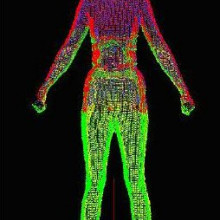
31:47 - Sexy Symmetry
Sexy Symmetry
with Dr William Brown, Brunel University
Have you ever spotted someone you can't seem to take your eyes off? The reason could be that person is more symmetrical than most. It's been known for a while the more symmetrical a person is, the more attractive we tend to find them. Dr William Brown who's at Brunel University has been using 3 dimensional scanning technology to look into the area a little bit more closely and to see just how finely tuned our sense for symmetry are. We sent Meera Senthillingham down to Brunel to find out more about the research and also to find out about her own symmetry...
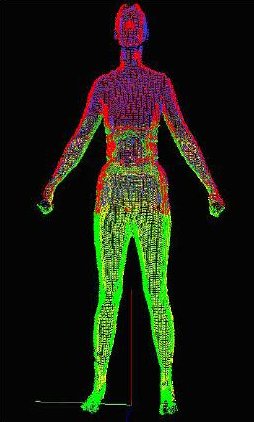 William - There's several things - looking at the association between symmetry and bodily attractiveness and also trying to improve the ability to measure the subtle asymmetries between the left and right side of the body. These symmetries, I need to point out, are subtle. They're so subtle that we need to measure them with very precise equipment.
William - There's several things - looking at the association between symmetry and bodily attractiveness and also trying to improve the ability to measure the subtle asymmetries between the left and right side of the body. These symmetries, I need to point out, are subtle. They're so subtle that we need to measure them with very precise equipment.
Meera - What have you been doing here at Brunel to look into this?
William - I met up with some people from engineering design who had purchased a 3D scanner that is used in the medical and textiles industries to get 3-dimensional images quite quickly: about 5-6 seconds for a scan. 24 cameras around the individual, flashes optical light and puts together a surface scan of that person's body. I'm using it for the first time to measure the subtle difference between the left and right side of the body.
Meera - We are actually by the scanner. It's my turn to actually go inside and have my body scanned. You've already taken my height and my weight so now I guess I just have to go inside...
Scanner voice - Welcome to the NX-12, [TC]²'s new 3D body scanner. Place your feet as shown by the footprints on the floor and grip the handle. When you are ready to start your scan...
Meera - I've finished my scan now which was quite a surreal experience, actually. We've got my profile on the computer. What can you see so far, Will?
William - Because it's 3-dimensional information it's called a point cloud display. There's thousands of little points on the body.
Meera - The actual image is quite amazing. It is an entire person made purely of lots of dots. There's a measurement at each of these dots.
William - Exactly. At some traits there's sub-millimetre accuracy in measurements. What it's done is measure everything in girths to lengths. It tells me the waist circumference to waist circumference.
Meera - What's my leg length?
William - We can do leg measurement, we can do something like get your ankle girth. Your right ankle girth is 269.9mm. I cannot just eyeball this and say you're more symmetrical or you're more asymmetrical than average because we need to put this into statistical software comparing you to the rest of the sample.
Meera - It's very strange seeing myself made up of many, many dots. You had people analysing and rating these samples you had.
William - Yes, they were simply rating these 360 degree videos for attractiveness.
Meera - What did you find?
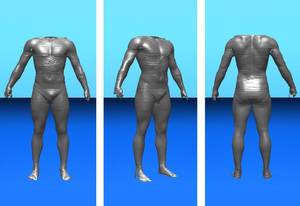 William - What we found was, if you're a male with more masculine body proportions, broad shoulders, they are rated as more attractive. Females though, with more curvy figures are rated as more attractive. That's not the interesting part, because we already knew and expected that finding. The interesting finding is that individuals with a higher degree of sex-typical features (what I means is guys with more masculine bodies) are in fact more symmetrical in the left and right side. Women with more feminised bodies and physiques are more symmetrical. Both symmetry and your degree of masculinity are associated with attractiveness ratings.
William - What we found was, if you're a male with more masculine body proportions, broad shoulders, they are rated as more attractive. Females though, with more curvy figures are rated as more attractive. That's not the interesting part, because we already knew and expected that finding. The interesting finding is that individuals with a higher degree of sex-typical features (what I means is guys with more masculine bodies) are in fact more symmetrical in the left and right side. Women with more feminised bodies and physiques are more symmetrical. Both symmetry and your degree of masculinity are associated with attractiveness ratings.
Meera - What do you think that it is about someone being symmetrical that's reflected for them to be more attractive?
William - A lot of people in general, it may not be clear to them that it's not the asymmetries themselves that we're detecting. The asymmetries themselves are tapping into something very difficult to measure: how difficult your development is. If you are having poor development which could be cause by all sorts of things: bad genes, bad environments, stress, pathogens or infection starting off from the womb throughout development. I can give you a quick example, some of the work that was first done on asymmetry was done by fish biologists and modelling biologists. What they found was in polluted lakes and streams the fishes there would have more asymmetries. The exact same species in the fresh lake that's not polluted were more symmetrical. It's used as an indicator for maybe population stress. What the subtle asymmetries we're tapping into is probably poor development. Individuals that are better able to be better developers would be ideal mates. Not just are you passing the genetic resources by giving individuals parents who aren't so ill but some of those environmental things can actually be passed onto your offspring to the individual during copulation.
Meera - So I'm assuming that someone's symmetry can change throughout their lives. Is it fair to say it would probably be at its peak when they're at their mating peak?
William - Exactly. That is the hypothesis. There is some cross-sectional data which means different people across different ages supporting that hypothesis. I think a lot of people fail to realise it's not like you're born symmetrical and you stay with the exact same symmetry through your entire lifespan. There's very few longitudinal studies done tracking youngsters all the way through to when they're older. Development is not just about a one gene for symmetry. Development's a very dynamic process. It's going to be difficult given your conditions to develop a symmetrical human. What they seem to find is, early on in development when you're going through that kind of growth spurt and putting on weight. The faster that rate is the more asymmetrical you are because that's stressful to develop. When you start to get beyond that growth spurt and reach a peak breeding period you'd be more symmetrical. After that period there may be some decline. You may expect individuals to become more asymmetrical. The rate of decline may be your health and other factors.
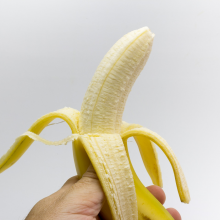
38:17 - Evolutionary Advantages of Sex
Evolutionary Advantages of Sex
with Robert Foley, Leverhulme Centre for Human Evolutionary Studies
Chris - To help us understand a bit more about the benefit of having sex in the first place is Robert Foley. He's the director of the Leverhulme Centre for Human Evolutionary Studies in Cambridge. Thanks for joining us on the Naked Scientists. Why have sex at all? Why aren't we just clone ourselves, reproducing ourselves? Why don't we just give birth to a copy of ourselves and populate the world with millions of clones like greenfly do?
Robert - Well, sex has been around for millions of years and is one of the ways of evolution operating. We don't fully understand why having two sexes rather than just one is the best thing. Once you've got it, it's absolutely critical. We often think of evolution as simply the survival of the fittest - it's how long we live that matters. It's not. It's how many offspring you have, it's how many of your genes you can get into the next generation. For a sexually-reproducing organism such as any animal it's absolutely critical. Your mating behaviour and how you bring up your young. So much selection is focussed on getting it right.
Chris - What is the benefit of having two sexes and mixing genes up the way that sex between two genetically-different individuals does? There have been a number of theories. Probably the best one is that it really jumbles up the genes in such a way that it partly allows organisms to adapt to new environments. As the environment changes you're not stuck with something by endlessly re-scrambling it. You're raising, in a lottery sense, the chances of something better coming which will help you survive. The other is that probably the ability to resist disease is one of the critical factors in this. We know that some of the disease associated with resisting disease are ones that evolve very rapidly and benefit from this reshuffling.
Chris - I suppose nature's good at examples of what happens if you do just clone yourself. We have potato famines in Ireland, we have the loss of the Cavendish banana because of panama disease because bananas are all clones. I suppose there is a benefit because we're still here. We haven't succumbed to some horrible disease because we have sex.
Robert - I think both systems - asexual and sexual reproduction - work very well in the right context. Once you're into very complex organisms, or which humans, primates, monkeys, animals are some. It probably just would be completely impossible to deal with this asexually.
Chris - What flies in the face of what you're saying is the fact that I chose my wife, I married her and have two children with her. If I wanted to mix my genes up as much as possible then I wouldn't just stick with one person. Why do I want to do that?
Robert - It's easier to look across animals and immediately we see there's an enormous variety of ways of reproducing Monogamy is just one. It's actually very rare one. Most animals will mate in a very promiscuous way and move on to the next partner. If we try and ask the question, 'under what circumstances do animals stay with one another?' It's probably, broadly speaking where the costs of bringing up offspring are very high. We know with humans we take a long time to grow, we have a large brain. It's very expensive for the mother and so somewhere in our evolutionary path there has been a general tendency to increase the amount of parental care. That means females have to be very choosy and males have to hang around and help bring up the offspring in some way or another.
Chris - It's interesting though because if you look at those voles that Larry Young was talking about earlier in the programme they have very large litters and the costs are not that high because they're just producing so many offspring there's a chance they're going to survive no matter what. Does that rule apply there?
Robert - There are a number of different reasons why. The other reason is where a male might not be able to defend an area or defend a number of females. In that sense he's forced into monogamy. I think one shouldn't get too fixed ideas about monogamy and other forms. Actually, in practise most animals are very flexible. They take the opportunity. Even birds that we think of as highly monogamous, turns out that something like 15% of their offspring are actually fathered by another bird floating in and taking the opportunities.

43:06 - Musical Milk?
Musical Milk?
We put this to Hugh Hunt, Department of Engineering, University of Cambridge:
I've got an experiment here which makes the effect more apparent. I'm actually going to fill up a mug with just some cold water and then I'm going to put in a spoon of Alka-Seltzer. That's going to make it fizz up. If I tap the bottom of the cup you can hear a noise. Now I'm going to put in a spoon of Alka-Seltzer now and stir it up. Now...
I don't know whether you can hear that but the pitch of the sound has gone right down. Now we wait a bit. The pitch is coming back up again. If I give it a bit of a stir, down it goes in pitch and then up it comes again. It's pretty clear this has got something to do with the bubbles. When you're frothing milk or you're having Alka-Seltzer into a cup you're turning water with no bubbles into water with bubbles. The bubbles add elasticity. Water is really highly incompressible. The presence of a few bubbles in the water make it a lot softer. Anything that's softer like something bouncing up and down on a soft rubber band will have a lower frequency than something bouncing on a stiff rubber band which will have a higher frequency. This is commonly called the hot chocolate effect and some people call it the cheap instant coffee effect. It's pretty easy to do but the explanation is not straightforward.
When it comes to milk, milk is a bit complicated really because when it gets hot the proteins denature and this is going to affect the way it forms the froth or the foam. The exact temperature when the effect becomes most pronounced will really depend on how much protein there is in the milk. But the basic effect is to do with the bubbles.
That can be most easily demonstrated with water.

If symmetry is sexy, what about flatfish?
Robert - Symmetry is good but it isn't always good. Like everything else in evolution when selection is strong enough it will change things. The benefits of being able to see for a flounder clearly outweight the benefits of symmetry and so evolution has shaped it. It yet again shows there are many different ways of surviving and reproducing in nature.

Can you read genetic fitness in the face?
Robert - Well not directly. Fortunately we don't all come with genetic labels on our faces like barcodes but we do know that our facial structure's like everything else, strongly under genetic control. What we also know is people are extraordinarily good at recognising faces. We can pick faces out or very complex backgrounds and that is enormously important for us to be able to separate individuals out. The answer's almost certainly yes. It's one of the best things we're at. Of course, we can do it between individuals and very easily between populations.
- Previous Carbon: Chemistry in its element
- Next Balloon Force Fields









Comments
Add a comment